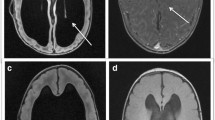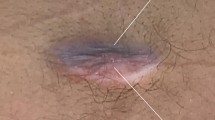Abstract
Background
Lipomyelomeningocele (LMMC) is defined by a low-lying tethered spinal cord protruding posteriorly from the spinal canal and terminating in a lipomatous mass in the subcutaneous meningeal sac. The coexistence of LMMC with split cord malformation (SCM) is rare.
Clinical presentation
We report on a patient with laterally protruded LMMC arising from the hemicord of SCM type I. Direct coronal and axial views (instead of sagittal views) of 3D heavily T2-weighted MR imaging (3D–hT2WI) clearly demonstrated the topographical relationship between both of the hemicords, the bony septum, and nerve roots in the right subcutaneous meningeal sac.
Conclusion
Combined use of axial and coronal images of 3D–hT2W is useful for visualization and surgery of such a complicated anomaly.


Similar content being viewed by others
References
Arai H, Sato K, Okuda O, Miyajima M, Hishii M, Nakanishi H, Ishii H (2001) Surgical experience of 120 patients with lumbosacral lipomas. Acta Neurochir 143:857–864
Dhandapani S, Srinivasan A (2016) Contiguous triple spinal dysraphism associated with Chiari malformation type II and hydrocephalus: an embryological conundrum between the unified theory of pang and the unified theory of McLone. J Neurosurg Pediatr 17:103–106
Finn MA, Walker ML (2007) Spinal lipomas: clinical spectrum, embryology, and treatment. Neurosurg Focus 23:E10
Hanif H, Khanbabazadeh S, Nejat F, El Khashab M (2013) Tethered cord with tandem lipomyelomeningoceles, split cord malformation and thick filum. J Pediatr Neurosci 8:204–206
Hashiguchi K, Morioka T, Fukui K, Miyagi Y, Mihara F, Yoshiura T, Nagata S, Sasaki T (2005) Usefulness of constructive interference in steady-state magnetic resonance imaging in the presurgical examination for lumbosacral lipoma. J Neurosurg 103:537–543
Hashiguchi K, Morioka T, Yoshida F, Miyagi Y, Mihara F, Yoshiura T, Nagata S, Sasaki T (2007) Feasibility and limitation of constructive interference in steady-state (CISS) MR imaging in neonates with lumbosacral myeloschisis. Neuroradiology 49:579–585
Kanev PM, Lamire RJ, Loeser JD, Berger M (1990) Management and long-term follow-up review of children with lipomyelomeningoceles, 1952-1987. J Neurosurg 73:48–52
McLone DG, Mutluer S, Naidich TP (1983) Lipomyelomeningoceles of the conus medullaris. In: Raimondi AJ (ed) Concepts in pediatric neurosurgery. Karger, Basel, pp 170–177
Morioka T, Hashiguchi K, Yoshida F, Nagata S, Miyagi Y, Mihara F, Sasaki T (2007) Dynamic morphological changes in lumbosacral lipoma during the first months of life revealed by constructive interference in steady-state (CISS) MR imaging. Childs Nerv Syst 23:415–420
Murakami N, Morioka T, Hashiguchi K, Yoshiura T, Hiwatashi A, Suzuki SO, Nakamizo A, Amano T, Hata N, Sasaki T (2013) Usefulness of three-dimensional T1-weighted spoiled gradient-recalled echo and three-dimensional heavily T2-weighted images in preoperative evaluation of spinal dysraphism. Childs Nerv Syst 29:1905–1914
Pang D, Dias MS, Ahab-Barmada M (1992) Split cord malformation: part I: a unified theory of embryogenesis for double spinal cord malformations. Neurosurgery 31:451–480
Pang D, Zovickian J, Lee YJ, Moes GS, Wang KC (2012) Terminal Myelocystocele: surgical observations and theory of embryogenesis. Neurosurgery 70:1383–1405
Parmar H, Patkar D, Shah J, Maheshwari M (2003) Diastematomyelia with terminal lipomyelocystocele arising from one hemicord: case report. Clin Imaging 27:41–43
Pierre-Kahn A, Zerah M, Renier D, Cinalli G, Sainte-Rose C, Lellouch-Tubiana A, Brunelle F, Le Merrer M, Giudicelli Y, Pichon J, Kleinknecht B, Nataf F (1997) Congenital lumbosacral lipomas. Childs Nerv Syst 13:298–334
Salunke P, Futane SS, Aggarwal A (2012) Split cord malformation type II with twin dorsal lipomas. J Neurosurg Pediatr 9:627–629
Shetty DS, Lakhkar BN (2002) Lateral sacral lipomyelomeningocele : a rare anomaly. Neurol India 50:204–206
Shieh C, Lam CH (2006) A lateral cervical lipomyelomeningocele associated with diplomyelia. Pediatr Neurosurg 42:399–403
Tortori-Donati P, Rossi A, Cama A (2000) Spinal dysraphism: a review of neuroradiological features with embryological correlations and proposal for a new classification. Neuroraiol 42:471–491
Author information
Authors and Affiliations
Corresponding author
Ethics declarations
Conflict of interest
The authors declare that they have no conflicts of interest.
Informed consent
Informed consent for the publication of the case report was obtained from the parents of the baby girl.
Rights and permissions
About this article
Cite this article
Murakami, N., Morioka, T., Ichiyama, M. et al. Lateral lipomyelomeningocele of the hemicord with split cord malformation type I revealed by 3D heavily T2-weighted MR imaging. Childs Nerv Syst 33, 993–997 (2017). https://doi.org/10.1007/s00381-017-3350-0
Received:
Accepted:
Published:
Issue Date:
DOI: https://doi.org/10.1007/s00381-017-3350-0




